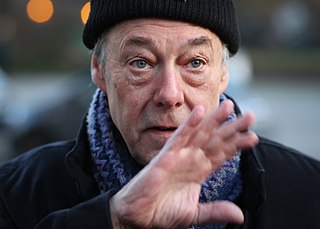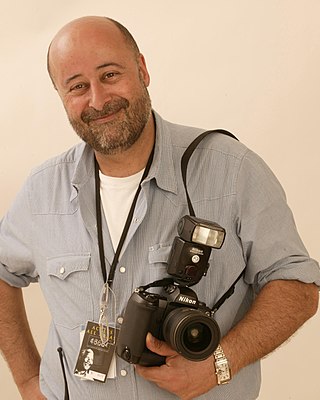
Tony Mendoza (born 1941) is a Cuban-American photographer.

Tony Mendoza (born 1941) is a Cuban-American photographer.
He was born as Antonio Mendoza in Havana and moved to Miami with his family in 1960. He graduated from Yale with a Bachelor of Engineering and Harvard with a Master of Architecture, before becoming a full-time photographic artist in 1973. Married to Maria del Carmen from Esperanza, Cuba, and they have two children Alex and Lydia. [ citation needed ]
Mendoza taught in the photography department at the Ohio State University in Columbus, Ohio from 1988 until his retirement in 2013. [1]
This section of a biography of a living person does not include any references or sources .(December 2020) |
His most famous book, Ernie, is a photographic memoir centered on a cat he encountered when he moved into an apartment in New York City. Mendoza has received three National Endowment for the Arts Fellowships, a Guggenheim Photography Fellowship as well as two Creative Writing fellowships from the Ohio Arts Council.
His photographs have featured in many major museums.[ which? ]

Ansel Easton Adams was an American landscape photographer and environmentalist known for his black-and-white images of the American West. He helped found Group f/64, an association of photographers advocating "pure" photography which favored sharp focus and the use of the full tonal range of a photograph. He and Fred Archer developed a system of image-making called the Zone System, a method of achieving a desired final print through a technical understanding of how the tonal range of an image is the result of choices made in exposure, negative development, and printing.

Martin Parr is a British documentary photographer, photojournalist and photobook collector. He is known for his photographic projects that take an intimate, satirical and anthropological look at aspects of modern life, in particular documenting the social classes of England, and more broadly the wealth of the Western world.

Sally Mann HonFRPS is an American photographer who has made large format black and white photographs—at first of her young children, then later of landscapes suggesting decay and death.
Robert Adams is an American photographer who has focused on the changing landscape of the American West. His work first came to prominence in the mid-1970s through his book The New West (1974) and his participation in the exhibition New Topographics: Photographs of a Man-Altered Landscape in 1975. He has received two Guggenheim Fellowships, a MacArthur Fellowship, the Deutsche Börse Photography Prize and the Hasselblad Award.

Garry Winogrand was an American street photographer, known for his portrayal of U.S. life and its social issues, in the mid-20th century. Photography curator, historian, and critic John Szarkowski called Winogrand the central photographer of his generation.

Peter Henry Emerson was a British writer and photographer. His photographs are early examples of promoting straight photography as an art form. He is known for taking photographs that displayed rural settings and for his disputes with the photographic establishment about the purpose and meaning of photography.

Duane Michals is an American photographer. Michals's work makes innovative use of photo-sequences, often incorporating text to examine emotion and philosophy.

Stephen Shore is an American photographer known for his images of scenes and objects of the banal, and for his pioneering use of color in art photography. His books include Uncommon Places (1982) and American Surfaces (1999), photographs that he took on cross-country road trips in the 1970s.

William Klein was an American-born French photographer and filmmaker noted for his ironic approach to both media and his extensive use of unusual photographic techniques in the context of photojournalism and fashion photography. He was ranked 25th on Professional Photographer's list of 100 most influential photographers.

Alec Soth is an American photographer, based in Minneapolis. Soth makes "large-scale American projects" featuring the midwestern United States. New York Times art critic Hilarie M. Sheets wrote that he has made a "photographic career out of finding chemistry with strangers" and photographs "loners and dreamers". His work tends to focus on the "off-beat, hauntingly banal images of modern America" according to The Guardian art critic Hannah Booth. He is a member of Magnum Photos.
Ralph Gibson is an American art photographer best known for his photographic books. His images often incorporate fragments with erotic and mysterious undertones, building narrative meaning through contextualization and surreal juxtaposition.
Mark Power is a British photographer. He is a member of Magnum Photos and Professor of Photography in The Faculty of Arts and Architecture at the University of Brighton. Power has been awarded the Terence Donovan Award and an Honorary Fellowship from the Royal Photographic Society.
Mario Algaze was a Cuban-American photographer who photographed musicians and celebrities, in rural and urban areas, throughout Latin America.

David Hurn is a British documentary photographer and member of Magnum Photos.

Sandro Miller is an American photographer,, known for his expressive images, his close work with actor John Malkovich and the other ensemble members of Chicago’s Steppenwolf Theatre Company.

Manuel Rivera-Ortiz is a stateside Puerto Rican photographer. He is best known for his social documentary photography of people's living conditions in less developed nations. Rivera-Ortiz lives in Rochester, New York and in Zurich.
Mikkel Aaland is a Norwegian-American photographer, based in San Francisco and Norway. He is known for work in the early days of digital photography, as well as his twelve books on photography. He is best known for his 1978 book Sweat, an illustrated history of sweat bathing. His documentary photographs have been exhibited in major institutions around the world, including the Bibliothèque Nationale in Paris and the former Lenin Museum in Prague. Aaland is the author of works of memoir, books featuring his own photojournalism as well as works on digital imaging and various Adobe Photoshop products.

Gerald David "Gerry" Badger is an English writer and curator of photography, and a photographer.

Richard Young is an English society and celebrity photographer. His photography career started in 1974 and since then, he has photographed personalities such as Diana, Princess of Wales, Elizabeth Taylor, and Mick Jagger.
Jonathan Green is an American writer, historian of photography, curator, teacher, museum administrator, photographer, filmmaker and the founding Project Director of the Wexner Center for the Arts. A recognized authority on the history of American photography, Green’s books Camera Work: A Critical Anthology (1973) and American Photography: A Critical History 1945–1980 (1984) are two notable commentaries and frequently referenced and republished accounts in the field of photography. At the same time Green’s acquisitions, exhibitions and publications consistently drew from the edges of established photographic practice rather than from its traditional center. He supported acquisitions by socially activist artists like Adrian Piper and graffiti artist Furtura 2000, and hosted exhibitions on Rape, AIDS, new feminist art, and the work of photographer, choreographer and dancer Arnie Zane, the Diana camera images of Nancy Rexroth, the Polaroids and imitation biplanes of folk artist Leslie Payne, and the digital photographic work of Mexican photographer Pedro Meyer. This alternative focus help prime Green and the competition jury to choose an unconventional, deconstructive architect, Peter Eisenman, previously known primarily as a teacher and theorist, as the architect for the Wexner Center for the Arts. Green has held professorial and directorial positions at Massachusetts Institute of Technology, Ohio State University, and University of California, Riverside.